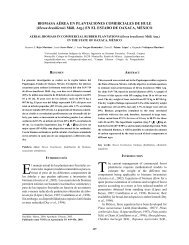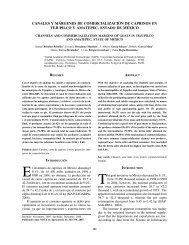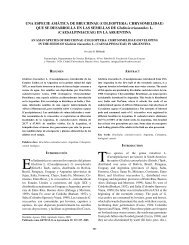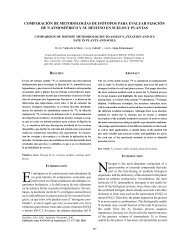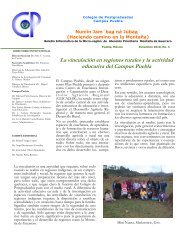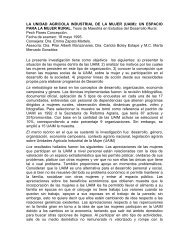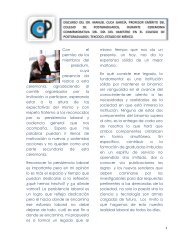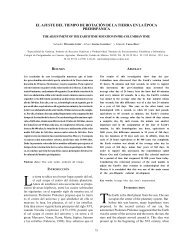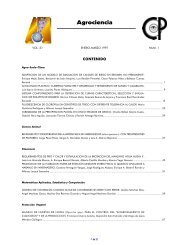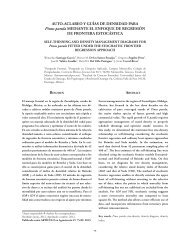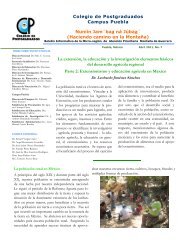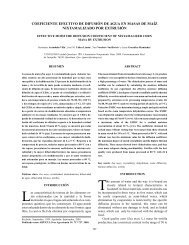Inseminación artificial intrauterina en cabras criollas con semen
Inseminación artificial intrauterina en cabras criollas con semen
Inseminación artificial intrauterina en cabras criollas con semen
You also want an ePaper? Increase the reach of your titles
YUMPU automatically turns print PDFs into web optimized ePapers that Google loves.
INSEMINACIÓN ARTIFICIAL INTRAUTERINA EN CABRAS<br />
CRIOLLAS CON SEMEN REFRIGERADO<br />
INTRAUTERINE ARTIFICIAL INSEMINATION IN CREOLE GOATS WITH COOLED SEMEN<br />
Rubén D. Martínez-Rojero1 , Javier Hernández-Ignacio2 , Humberto Hernández-Hernández1 ,<br />
Alejandro C. Michel-Aceves1 y Javier Val<strong>en</strong>cia-Méndez 3<br />
1 C<strong>en</strong>tro de Estudios Profesionales. Colegio Superior Agropecuario del Estado de Guerrero. Av<strong>en</strong>ida<br />
Vic<strong>en</strong>te Guerrero Núm. 81. Iguala, Guerrero. (csaegro@prodigy.net.mx). 2 Asociación Mexicana de<br />
Médicos Veterinarios Especialistas <strong>en</strong> Bovinos (tysonjhi@hotmail.com). 3 CEPIPSA. Facultad de<br />
Medicina Veterinaria y Zootecnia. UNAM.<br />
RESUMEN<br />
El objetivo del pres<strong>en</strong>te estudio fue evaluar la tasa de fertilidad<br />
y el índice de prolificidad de <strong>cabras</strong> <strong>criollas</strong> inseminadas <strong>intrauterina</strong>m<strong>en</strong>te<br />
<strong>con</strong> sem<strong>en</strong> refrigerado, o servidas por monta natural.<br />
El trabajo se llevó a cabo durante la época reproductiva. Las<br />
<strong>cabras</strong> fueron sincronizadas <strong>con</strong> esponjas intravaginales <strong>con</strong>t<strong>en</strong>i<strong>en</strong>do<br />
40 mg de acetato de flurogestona (FGA) durante 11 d,<br />
más 200 UI de gonadotropina coriónica equina (eCG) aplicadas<br />
intramuscularm<strong>en</strong>te al retirar las esponjas. Las <strong>cabras</strong> fueron<br />
servidas por monta natural (n=41) o inseminadas <strong>intrauterina</strong>m<strong>en</strong>te<br />
<strong>con</strong> sem<strong>en</strong> refrigerado (n=40) mediante laparoscopía,<br />
24 h después de detectar el estro. Se utilizaron pruebas de χ2 y<br />
análisis de varianza. La fertilidad obt<strong>en</strong>ida por monta natural<br />
fue 82.5% mayor (p≤0.05) a la registrada por inseminación <strong>artificial</strong><br />
(67.5%); pero no se <strong>en</strong><strong>con</strong>tró difer<strong>en</strong>cia (p>0.05) <strong>en</strong>tre tratami<strong>en</strong>tos<br />
para el índice de prolificidad, que fue 1.20±0.41 crías<br />
por parto para monta natural y 1.18±0.39 crías por parto para<br />
inseminación <strong>artificial</strong>. Se <strong>con</strong>cluye que la fertilidad obt<strong>en</strong>ida<br />
<strong>con</strong> sem<strong>en</strong> refrigerado es moderada y es m<strong>en</strong>or que la registrada<br />
por monta natural. El índice de prolificidad no fue afectado por<br />
el tipo de servicio utilizado.<br />
Palabras clave: Capra hircus, sem<strong>en</strong> refrigerado.<br />
INTRODUCCIÓN<br />
Al igual que <strong>en</strong> otras especies domésticas, la inseminación<br />
<strong>artificial</strong> (IA) <strong>en</strong> caprinos es una<br />
alternativa para una máxima utilización de sem<strong>en</strong>tales<br />
valiosos, que son g<strong>en</strong>éticam<strong>en</strong>te superiores.<br />
El sem<strong>en</strong> del macho mejorado puede ser utilizado para<br />
IA <strong>en</strong> forma fresca, refrigerada o <strong>con</strong>gelada. En forma<br />
fresca mant<strong>en</strong>ido a 30 °C (ya sea diluido o no), el<br />
sem<strong>en</strong> debe ser utilizado inmediatam<strong>en</strong>te después de<br />
su recolección, porque la motilidad y viabilidad de los<br />
espermatozoides <strong>en</strong> estas <strong>con</strong>diciones se reduce rápidam<strong>en</strong>te,<br />
debido al increm<strong>en</strong>to <strong>en</strong> la <strong>con</strong>c<strong>en</strong>tración de<br />
Recibido: Febrero, 2005. Aprobado: Octubre, 2005.<br />
Publicado como NOTA <strong>en</strong> Agroci<strong>en</strong>cia 40: 71-76. 2006.<br />
71<br />
ABSTRACT<br />
The objective of the pres<strong>en</strong>t study was to evaluate the fertility<br />
rate and prolificity index of Creole goats, either inseminated<br />
into the uterus with cooled sem<strong>en</strong>, or served by natural mating.<br />
The study took place during the breeding season. Goats were<br />
synchronized with intravaginal sponges <strong>con</strong>taining 40 mg of<br />
flurogestone acetate (FGA) during 11 d, plus an intramuscular<br />
injection of equine corionic gonadotropin (eCG) wh<strong>en</strong> sponges<br />
were withdrawn. Goats were served either by natural mating<br />
(n=41) or inseminated into the uterus by laparoscopy (n=40)<br />
with cooled sem<strong>en</strong> 24 h after estrus was detected. Data were<br />
analyzed by χ2 tests and variance analysis. The fertility rate<br />
(82.5%) obtained by natural mating was higher (p≤0.05) than<br />
that obtained by <strong>artificial</strong> insemination (67.5%). No differ<strong>en</strong>ces<br />
were found (p>0.05) for the prolificity rate betwe<strong>en</strong> natural<br />
mating (1.20±0.41 kids per goat) and <strong>artificial</strong> insemination<br />
(1.18±0.39 kids per goat). It is <strong>con</strong>cluded that a moderate fertility<br />
was obtained by cooled sem<strong>en</strong>, however, it was lower than that<br />
registered for natural mating. Prolificity index was not affected<br />
by the form in which goats were served.<br />
Key words: Capra hircus, cooled sem<strong>en</strong>.<br />
INTRODUCTION<br />
As with other domestic species, <strong>artificial</strong><br />
insemination (AI) in goats is an alternative for<br />
the maximum utilization of valuable breeding<br />
males that are g<strong>en</strong>etically superior. The sem<strong>en</strong> of the<br />
improved male can be used for AI in fresh, cooled or<br />
froz<strong>en</strong> form. In its fresh form maintained at 30 °C (diluted<br />
or undiluted), the sem<strong>en</strong> should be used immediately<br />
after it is collected, as the motility and viability of the<br />
spermatozoids under these <strong>con</strong>ditions is quickly reduced,<br />
due to the increase in the <strong>con</strong>c<strong>en</strong>tration of lactic acid<br />
in the ejaculate (Vivanco, 1990). The above does not<br />
give the opportunity to transport the fresh sem<strong>en</strong> to be<br />
used in farms that are distant, either from the breeding<br />
c<strong>en</strong>ters or from the farms where the improved males are<br />
found. However, the viability of the sem<strong>en</strong> preserved in
AGROCIENCIA, ENERO-FEBRERO 2006<br />
ácido láctico <strong>en</strong> el eyaculado (Vivanco, 1998). Lo anterior<br />
no da oportunidad de trasladar el sem<strong>en</strong> fresco<br />
para utilizarlo <strong>en</strong> granjas alejadas, ya sea de los c<strong>en</strong>tros<br />
de mejorami<strong>en</strong>to g<strong>en</strong>ético o de las granjas donde<br />
se alojan los sem<strong>en</strong>tales mejorados. Por el <strong>con</strong>trario, la<br />
viabilidad del sem<strong>en</strong> preservado <strong>en</strong> refrigeración puede<br />
mant<strong>en</strong>erse 48 h o más (Evans y Maxwell, 1990),<br />
lo que permite mayor flexibilidad de uso <strong>en</strong> programas<br />
de IA, para explotaciones caprinas aledañas donde se<br />
quiera usar machos g<strong>en</strong>éticam<strong>en</strong>te superiores para los<br />
rebaños criollos locales.<br />
La técnica más simple para IA <strong>en</strong> pequeños rumiantes<br />
<strong>con</strong>siste <strong>en</strong> depositar el sem<strong>en</strong> <strong>en</strong> la <strong>en</strong>trada o d<strong>en</strong>tro<br />
del cervix o <strong>en</strong> pasar el cateter o pistola de inseminación<br />
a través del mismo para depositarlo directam<strong>en</strong>te d<strong>en</strong>tro<br />
del útero (Evans y Maxwell, 1990), lo que a veces es imposible<br />
(sobre todo <strong>en</strong> animales jóv<strong>en</strong>es), dado el tamaño<br />
y la estructura del cervix (Vivanco, 1998; Mareco, 2004).<br />
La inseminación <strong>intrauterina</strong> <strong>con</strong> sem<strong>en</strong> refrigerado utilizando<br />
un laparoscopio permite depositar el sem<strong>en</strong> directam<strong>en</strong>te<br />
d<strong>en</strong>tro del útero cerca del oviducto, poco antes<br />
de la ovulación, lo cual podría producir tasas de fertilidad<br />
comparables a las obt<strong>en</strong>idas por monta natural, dado<br />
que la principal causa de disminución de la fertilidad del<br />
sem<strong>en</strong> refrigerado parece ser una capacidad alterada de<br />
transporte de los espermatozoides desde el cervix hasta<br />
el lugar de fertilización <strong>en</strong> el oviducto (Evans y Maxwell,<br />
1990). Sin embargo, no se <strong>en</strong><strong>con</strong>traron trabajos <strong>en</strong> <strong>cabras</strong><br />
que evaluan la tasa de fertilidad obt<strong>en</strong>ida <strong>con</strong> IA <strong>intrauterina</strong>,<br />
utilizando sem<strong>en</strong> refrigerado. El objetivo del pres<strong>en</strong>te<br />
estudio fue evaluar la tasa de fertilidad y la prolificidad<br />
de <strong>cabras</strong> <strong>criollas</strong> inseminadas <strong>intrauterina</strong>m<strong>en</strong>te<br />
<strong>con</strong> sem<strong>en</strong> refrigerado o servidas <strong>con</strong> monta natural.<br />
72<br />
MATERIALES Y MÉTODOS<br />
El estudio se realizó <strong>en</strong> un rebaño comercial de la comunidad<br />
de Tuxpan, municipio de Iguala, Guerrero; 18° 15’ N y 99° 38’ O. El<br />
clima de la región es Aw(w)(i’)g: cálido sub-húmedo, <strong>con</strong> lluvias <strong>en</strong><br />
el verano y sin estación invernal definida (García, 1988).<br />
Se utilizaron 100 <strong>cabras</strong> <strong>criollas</strong> de 2 a 4 años de edad, <strong>con</strong>dición<br />
corporal de 2 a 3, <strong>en</strong> una escala de 0 a 5 (Russel et al., 1969), durante<br />
la época reproductiva (octubre de 2002) sin <strong>con</strong>ocerse si estaban<br />
ciclando o no al inicio del experim<strong>en</strong>to. El rebaño experim<strong>en</strong>tal se<br />
mantuvo <strong>en</strong> <strong>con</strong>diciones ext<strong>en</strong>sivas, alim<strong>en</strong>tándose exclusivam<strong>en</strong>te<br />
de pastos, arbustos y grama nativa <strong>en</strong> los agostaderos de la región.<br />
Las <strong>cabras</strong> fueron desparasitadas internam<strong>en</strong>te <strong>con</strong> clorhidrato de<br />
levamisol y externam<strong>en</strong>te <strong>con</strong> productos organofosforados, además<br />
de ser inmunizadas cada seis meses <strong>con</strong>tra pasteurelosis y problemas<br />
digestivos, <strong>con</strong> bacterina mixta.<br />
Para la sincronización del estro se aplicaron a las hembras esponjas<br />
intravaginales <strong>con</strong>t<strong>en</strong>i<strong>en</strong>do 40 mg de acetato de flurogestona<br />
(FGA) por 11 d, más 200 UI de gonadotropina coriónica equina<br />
(eCG) administrada intramuscularm<strong>en</strong>te al retirar las esponjas. Una<br />
VOLUMEN 40, NÚMERO 1<br />
refrigeration can be maintained 48 h or more (Evans and<br />
Maxwell, 1990), which allows more flexibility for its use<br />
in AI programs for nearby goat farms which wish to use<br />
g<strong>en</strong>etically superior males for the local Creole herds.<br />
The simplest technique for AI in small ruminants<br />
<strong>con</strong>sists of depositing the sem<strong>en</strong> at the <strong>en</strong>trance of<br />
or within the cervix, or in passing the catheter or<br />
insemination pistol through the cervix, depositing the<br />
sem<strong>en</strong> directly into the uterus (Evans and Maxwell,<br />
1990), which is sometimes impossible (especially<br />
in young animals), giv<strong>en</strong> the size and structure of the<br />
cervix (Vivanco, 1998; Mareco, 2004). Intrauterine<br />
insemination with cooled sem<strong>en</strong> using laparoscopy<br />
makes it possible to deposit the sem<strong>en</strong> directly into<br />
the uterus near the oviduct, shortly before ovulation,<br />
which would produce fertility rates comparable to those<br />
obtained by natural mating, as the main cause of reduced<br />
fertility of the cooled sem<strong>en</strong> appears to be an alteration<br />
in the capacity to transport the spermatozoids from the<br />
cervix to the place of fertilization in the oviduct (Evans<br />
and Maxwell, 1990). However, no studies in goats were<br />
found aimed at evaluating the fertility rate obtained<br />
with intrauterine AI using cooled sem<strong>en</strong>. The objective<br />
of the pres<strong>en</strong>t study was to evaluate the fertility rate<br />
and prolificity of Creole goats served by intrauterine<br />
insemination with cooled sem<strong>en</strong> or by natural mating.<br />
MATERIALS AND METHODS<br />
The study was carried out in a commercial herd of the community<br />
of Tuxpan, municipality of Iguala, Guerrero; 18° 15’ N and 99° 38’ W.<br />
The climate of the region is Aw (w)(i’)g: warm sub-humid, with rains<br />
in summer and with no defined winter season (García, 1988).<br />
For this study, 100 Creole goats from 2 to 4 years of age were<br />
used, corporal <strong>con</strong>dition of 2 to 3, on a scale of 0 to 5 (Russel et al.,<br />
1969), during the breeding season (October of 2002), without knowing<br />
whether the goats were in estrus at the start of the experim<strong>en</strong>t. The<br />
experim<strong>en</strong>tal herd was maintained under ext<strong>en</strong>sive <strong>con</strong>ditions, feeding<br />
exclusively on grasses, shrubs and native grass in the grasslands of the<br />
region. The goats were internally treated for parasites with levamisol<br />
chlorohydrate, and externally treated with organophosphorated<br />
products, as well as being immunized every six months against<br />
pasteurellosis and digestive problems, with mixed bacterine.<br />
To synchronize estrus, intravaginal sponges were applied to the<br />
females, <strong>con</strong>taining 40 mg of flurogestone acetate (FGA) for 11 d,<br />
plus 200 UI of equine corionic gonadotropine (eCG) administered<br />
intramuscularly wh<strong>en</strong> the sponges were removed. Once removed,<br />
estrus was detected every 6 h with males fitted with an apron. Of the<br />
100 goats <strong>con</strong>sidered initially, 11 expelled the sponge and eight others<br />
did not pres<strong>en</strong>t estrus, thus 81 were used. Of those that pres<strong>en</strong>ted<br />
estrus, 41 were served 24 h later by natural mating by four Nubian<br />
males which had prov<strong>en</strong> to be fertile in previous matings, which were<br />
maintained separated from the herd until the start of mating. Another<br />
group of 40 goats was inseminated with cooled sem<strong>en</strong> from the Nubian
vez removidas, se procedió a la detección de estros cada 6 h mediante<br />
machos provistos <strong>con</strong> mandil. De las 100 <strong>cabras</strong> <strong>con</strong>sideradas inicialm<strong>en</strong>te<br />
11 tiraron la esponja y ocho más no mostraron estro, por lo<br />
que se utilizaron 81. De las que manifestaron celo, 41 fueron servidas<br />
24 h después por monta natural por cuatro machos Nubios que mostraron<br />
ser fértiles <strong>en</strong> empadres anteriores, los cuales se mantuvieron<br />
separados del rebaño hasta el inicio de las montas. Otro grupo de<br />
40 <strong>cabras</strong> fue inseminado <strong>con</strong> sem<strong>en</strong> refrigerado del macho Nubio<br />
de mejor calidad g<strong>en</strong>ética mediante laparoscopia, 24 h después de<br />
detectar el estro (Romano, 2004).<br />
El sem<strong>en</strong> fue recolectado 3 h antes del inicio de las inseminaciones<br />
mediante vagina <strong>artificial</strong> y se midió su volum<strong>en</strong> (<strong>en</strong> mL),<br />
motilidad masal (porc<strong>en</strong>taje) y <strong>con</strong>c<strong>en</strong>tración espermática (millones<br />
de células mL−1 ). Para preparar el diluy<strong>en</strong>te se utilizó: Triladyl<br />
(20%), agua destilada (60%) y yema de huevo (20%). La yema<br />
de huevo fue sometida previam<strong>en</strong>te a baño María a 56 °C durante<br />
30 min para inactivar las lecitinas (Val<strong>en</strong>cia, 1997). El diluy<strong>en</strong>te<br />
fue añadido al eyaculado a 30 °C <strong>en</strong> un sólo paso, utilizándose 100<br />
millones de espermatozoides por dosis. El sem<strong>en</strong> diluido fue colocado<br />
manualm<strong>en</strong>te <strong>en</strong> pajillas <strong>con</strong> capacidad de 0.25 mL a 30 °C,<br />
las cuales fueron selladas <strong>con</strong> alcohol polivinílico <strong>en</strong> polvo (Evans<br />
y Maxwell, 1990). Las pajillas selladas fueron colocadas <strong>en</strong> un<br />
recipi<strong>en</strong>te de plástico <strong>con</strong> agua a 30 °C. el cual fue introducido a<br />
una hielera de unicel <strong>con</strong> cubos de hielo, donde se mantuvo a 5 °C<br />
hasta la inseminación, d<strong>en</strong>tro de las sigui<strong>en</strong>tes 48 h después de su<br />
recolección.<br />
El sem<strong>en</strong> se depositó directam<strong>en</strong>te d<strong>en</strong>tro del útero mediante<br />
laparoscopía utilizando una pistola de inseminación cubierta <strong>con</strong> un<br />
aspic (media dosis <strong>en</strong> cada cuerno uterino; Martínez et al., 2003).<br />
Para ello, las <strong>cabras</strong> fueron sometidas a ayuno por 24 h para evitar<br />
lesionar vísceras <strong>con</strong> los trocars e inducirles anestesia disociativa<br />
sin provocarles regurgitación, utilizando xilacina intramuscular al<br />
2% (0.1 mL 10 kg−1 peso vivo), más ketamina intrav<strong>en</strong>osa (0.2 mL<br />
10 kg−1 peso vivo) 10 min después (Mejía, 1997). Luego de cinco<br />
meses se registró la ocurr<strong>en</strong>cia o no del parto, así como el número<br />
de crías por parto.<br />
Las variables evaluadas fueron el porc<strong>en</strong>taje de fertilidad (<strong>cabras</strong><br />
paridas/<strong>cabras</strong> servidas) y el índice de prolificidad (número de<br />
crías/cabra parida). Se usó una prueba de χ2 para datos de porc<strong>en</strong>taje<br />
de fertilidad, y análisis de varianza para experim<strong>en</strong>tos desbalanceados,<br />
utilizando un diseño completam<strong>en</strong>te al azar para el índice de<br />
prolificidad (Steel y Torrie, 1986).<br />
RESULTADOS Y DISCUSIÓN<br />
La tasa de fertilidad (82.5%) obt<strong>en</strong>ida por monta<br />
natural fue mayor (p≤0.05) a la registrada para la inseminación<br />
<strong>artificial</strong> (67.5%); pero no se <strong>en</strong><strong>con</strong>tró difer<strong>en</strong>cia<br />
(p>0.05) <strong>en</strong>tre tratami<strong>en</strong>tos para el índice de<br />
prolificidad, que fue 1.20±0.41 crías por parto para la<br />
monta natural y 1.18±0.39 crías por parto para la inseminación<br />
<strong>artificial</strong> (Cuadro 1). Los resultados muestran<br />
que la fertilidad alcanzada por IA <strong>intrauterina</strong> <strong>con</strong><br />
sem<strong>en</strong> refrigerado utilizando laparoscopía, fue m<strong>en</strong>or<br />
INSEMINACIÓN ARTIFICIAL INTRAUTERINA EN CABRAS CRIOLLAS CON SEMEN REFRIGERADO<br />
male of the best g<strong>en</strong>etic quality by means of laparoscopy, 24 h after<br />
estrus was detected (Romano, 2004).<br />
The sem<strong>en</strong> was collected 3 h before the start of the inseminations<br />
with an <strong>artificial</strong> vagina, and an evaluation was made of its volume<br />
(mL), mass motility (perc<strong>en</strong>tage) and spermatic <strong>con</strong>c<strong>en</strong>tration (millions<br />
of cells mL−1 ). For the preparation of the dilu<strong>en</strong>t, the following were<br />
used: Triladyl (20%), distilled water (60%) and egg yolk (20%). The<br />
egg yolk was previously subjected to a double boiler at 56 °C during<br />
30 min to inactivate the lecithins (Val<strong>en</strong>cia, 1997). The dilu<strong>en</strong>t was<br />
added to the ejaculate at 30 °C in a single step, using 100 million<br />
spermatozoids per dose. The diluted sem<strong>en</strong> was manually placed into<br />
straws with a capacity of 0.25 mL, at 30 °C, which were sealed with<br />
powdered polyvinyl alcohol (Evans and Maxwell, 1990). The sealed<br />
straws were placed in a plastic <strong>con</strong>tainer with water at 30 °C, which<br />
was introduced into a styrofoam cooler with ice cubes, where it was<br />
maintained at 5 °C until the insemination took place, within the 48 h<br />
following its collection.<br />
The sem<strong>en</strong> was deposited directly within the uterus by means<br />
of laparoscopy using an insemination pistol covered with aspic (half<br />
dose in each uterine horn; Martínez et al., 2003). For this purpose,<br />
the goats were subjected to fasting for 24 h to avoid injuries in the<br />
viscera from the trocars and induce dissociative anesthesia without<br />
provoking regurgitation, using intramuscular xylacin at 2% (0.1 mL<br />
10 kg −1 live weight), plus intrav<strong>en</strong>ous ketamine (0.2 mL 10 kg −1 live<br />
weight) 10 min later (Mejía, 1997). After five months, the occurr<strong>en</strong>ce<br />
or non-occurr<strong>en</strong>ce of the birth was recorded, as well as the number of<br />
kids per birth.<br />
The variables evaluated were the perc<strong>en</strong>tage of fertility (goats that<br />
delivered/goats served) and the prolificity index (number of kids/goat<br />
that gave birth). A χ2 test was used for fertility perc<strong>en</strong>tage data and<br />
a variance analysis for unbalanced experim<strong>en</strong>ts, using a completely<br />
randomized design for the prolificity index (Steel and Torrie, 1986).<br />
RESULTS AND DISCUSSION<br />
The fertility rate (82.5%) obtained by natural mating<br />
was higher (p≤0.05) than that registered for <strong>artificial</strong><br />
insemination (67.5%); but no differ<strong>en</strong>ce (p>0.05) was<br />
found among treatm<strong>en</strong>ts for the prolificity index, which<br />
was 1.20±0.41 kids per delivery for natural mating and<br />
1.18±0.39 kids per delivery for <strong>artificial</strong> insemination<br />
(Table 1). The results show that the fertility reached<br />
through intrauterine AI with cooled sem<strong>en</strong> using<br />
laparoscopy was lower than that obtained by natural<br />
mating, without affecting the prolificity index.<br />
For the <strong>artificial</strong> insemination, it was expected to<br />
obtain fertility similar to that of natural mating, as the<br />
cooled sem<strong>en</strong> was deposited within the uterus. Evans<br />
and Maxwell (1990) m<strong>en</strong>tion that with intrauterine<br />
insemination by laparoscopy, the cooled sem<strong>en</strong> may<br />
be used up to 6 d after its dilution. The causes of the<br />
moderate fertility were not established; although the<br />
cooling process seems to reduce the transport capacity<br />
of the spermatozoids at a rate of 10% to 35% per day of<br />
MARTÍNEZ-ROJERO et al.<br />
73
AGROCIENCIA, ENERO-FEBRERO 2006<br />
a la obt<strong>en</strong>ida por monta natural, sin afectar el índice de<br />
prolificidad.<br />
Para la inseminación se esperaba obt<strong>en</strong>er una fertilidad<br />
similar a la de monta natural, dado que el sem<strong>en</strong> refrigerado<br />
se depositó d<strong>en</strong>tro del útero. Evans y Maxwell<br />
(1990) m<strong>en</strong>cionan que <strong>con</strong> inseminación <strong>intrauterina</strong><br />
por laparoscopía el sem<strong>en</strong> refrigerado puede utilizarse<br />
hasta 6 d después de su dilución. No se establecieron las<br />
causas de la fertilidad moderada; aunque el proceso de<br />
refrigeración parece disminuir <strong>en</strong>tre 10% a 35% por día<br />
de almac<strong>en</strong>ami<strong>en</strong>to la capacidad de transporte de los<br />
espermatozoides (Evans y Maxwell, 1990). Otra posible<br />
explicación sería que como se ha observado <strong>en</strong> ovinos<br />
(Gillan y Maxwell, 1998), el <strong>en</strong>friami<strong>en</strong>to y la des<strong>con</strong>gelación<br />
del sem<strong>en</strong> del carnero induce la capacitación<br />
prematura de los espermatozoides, disminuy<strong>en</strong>do su capacidad<br />
fertilizante. Blash et al. (2000) <strong>en</strong><strong>con</strong>traron que<br />
el proceso de <strong>con</strong>gelación-des<strong>con</strong>gelación del sem<strong>en</strong> de<br />
caprino disminuyó de 86% a 60% el porc<strong>en</strong>taje de espermatozoides<br />
vivos/muertos y de 95% a 89% la integridad<br />
del acrosoma. Finalm<strong>en</strong>te, la pericia del técnico<br />
inseminador también influye <strong>en</strong> la fertilidad obt<strong>en</strong>ida<br />
por IA.<br />
La tasa de fertilidad para monta natural está d<strong>en</strong>tro<br />
de los intervalos reportados <strong>en</strong> la literatura. Las tasas<br />
de preñez de <strong>cabras</strong> <strong>criollas</strong> <strong>en</strong> <strong>con</strong>diciones ext<strong>en</strong>sivas<br />
del norte de México superan el 80%, <strong>en</strong> tanto que las<br />
tasas de pariciones de las <strong>cabras</strong> <strong>criollas</strong> del sur del país<br />
fluctúan <strong>en</strong>tre 39 y 96% (Mellado, 1997). La fertilidad<br />
(82.5%) obt<strong>en</strong>ida <strong>en</strong> este experim<strong>en</strong>to <strong>con</strong> monta natural<br />
es superior a la de 58.1% <strong>en</strong><strong>con</strong>trada por Martínez<br />
et al. (2000), <strong>en</strong> <strong>cabras</strong> <strong>criollas</strong> del norte de Guerrero,<br />
así como a 79% <strong>en</strong> <strong>cabras</strong> Nubias <strong>en</strong> la Costa Chica de<br />
Guerrero (Martínez y Cervantes, 1993).<br />
En la literatura revisada sólo se <strong>en</strong><strong>con</strong>tró información<br />
relacionada <strong>con</strong> inseminación <strong>artificial</strong> <strong>intrauterina</strong><br />
<strong>en</strong> <strong>cabras</strong> utilizando sem<strong>en</strong> <strong>con</strong>gelado. Dickson et al.<br />
(2001) registraron una fertilidad de 59.5%, ligeram<strong>en</strong>te<br />
m<strong>en</strong>or a la del pres<strong>en</strong>te estudio, <strong>en</strong> <strong>cabras</strong> lecheras (Alpino<br />
Francesa y Saan<strong>en</strong>) inseminadas <strong>intrauterina</strong>m<strong>en</strong>te<br />
<strong>con</strong> sem<strong>en</strong> <strong>con</strong>gelado, mi<strong>en</strong>tras que Karatzas et al.<br />
(1997) y Gooneward<strong>en</strong>e et al. (1997) obtuvieron sólo<br />
44.9 y 41.0%. Lowinger et al. (2001), <strong>en</strong> Arg<strong>en</strong>tina,<br />
reportan una fertilidad variable (0% a 40%) <strong>en</strong> <strong>cabras</strong><br />
de difer<strong>en</strong>tes granjas, inseminadas mediante laparoscopía<br />
d<strong>en</strong>tro del útero <strong>con</strong> sem<strong>en</strong> <strong>con</strong>gelado. La fertilidad<br />
también fue m<strong>en</strong>or a la registrada <strong>en</strong> el pres<strong>en</strong>te estudio<br />
<strong>con</strong> sem<strong>en</strong> refrigerado.<br />
No obstante que <strong>en</strong> este estudio no se evaluó su efecto<br />
podría suponerse que, de acuerdo <strong>con</strong> trabajos previos,<br />
la <strong>con</strong>dición corporal de las hembras al mom<strong>en</strong>to<br />
de ser servidas (2 a 3 <strong>en</strong> una escala de 0 a 5) no afectó<br />
la fertilidad. Gooneward<strong>en</strong>e et al. (1997), evaluaron el<br />
efecto de la nutrición antes y después del servicio, sobre<br />
74<br />
VOLUMEN 40, NÚMERO 1<br />
storage (Evans and Maxwell, 1990). Another possible<br />
explanation could be that, as has be<strong>en</strong> observed in sheep<br />
(Gillan and Maxwell, 1998), the cooling and thawing of<br />
the ram sem<strong>en</strong> induces the premature capacitation of the<br />
spermatozoids, reducing the fertilizing capacity. Blash<br />
et al. (2000) found that the freezing-thawing process<br />
of goat sem<strong>en</strong> reduced the perc<strong>en</strong>tage of live/dead<br />
spermatozoids from 86% to 60%, and the integrity of<br />
the acrosome from 95% to 89%. Finally, the expertise<br />
of the inseminating technician also has an influ<strong>en</strong>ce on<br />
the fertility obtained by AI.<br />
The fertility rate for natural mating is within the<br />
intervals reported in the literature. The pregnancy rates<br />
of Creole goats under ext<strong>en</strong>sive <strong>con</strong>ditions in the north<br />
of México are over 80%, whereas the delivery rates<br />
of the Creole goats of the southern part of the country<br />
fluctuate betwe<strong>en</strong> 39 and 96% (Mellado, 1997). The<br />
fertility (82.5%) obtained in this experim<strong>en</strong>t with<br />
natural mating is superior to that of 58.1% found by<br />
Martínez et al. (2000), in Creole goats of the north of<br />
Guerrero, as well as to that of 79% in Nubian goats on<br />
the Costa Chica of Guerrero (Martínez and Cervantes,<br />
1993).<br />
In the revised literature, information related only<br />
to intrauterine <strong>artificial</strong> insemination in goats using<br />
froz<strong>en</strong> sem<strong>en</strong> was found. Dickson et al. (2001)<br />
registered a fertility of 59.5%, slightly lower than<br />
that in the pres<strong>en</strong>t study, in milking goats (Fr<strong>en</strong>ch<br />
Alpine and Saan<strong>en</strong>) which had received intrauterine<br />
insemination with froz<strong>en</strong> sem<strong>en</strong>, whereas Karatzas et<br />
al. (1997) and Gooneward<strong>en</strong>e et al. (1997) obtained<br />
44.9 and 41.0%. Lowinger et al. (2001), in Arg<strong>en</strong>tina,<br />
report a variable fertility (0% to 40%) in goats of<br />
differ<strong>en</strong>t farms, inseminated by laparoscopy within<br />
the uterus with froz<strong>en</strong> sem<strong>en</strong>. The fertility was also<br />
lower than that registered in the pres<strong>en</strong>t study with<br />
cooled sem<strong>en</strong>.<br />
Cuadro 1. Tasa de fertilidad e índice de prolificidad de <strong>cabras</strong><br />
<strong>criollas</strong> inseminadas <strong>intrauterina</strong>m<strong>en</strong>te <strong>con</strong> sem<strong>en</strong> refrigerado<br />
o servidas por monta natural 24 h después<br />
de pres<strong>en</strong>tar estro.<br />
Table 1. Fertility rate and prolificity index of Creole goats that<br />
received intrauterine insemination with cooled sem<strong>en</strong> or<br />
that were served by natural mating 24 h after pres<strong>en</strong>ting<br />
estrus.<br />
Tipo de servicio n<br />
Tasa de Índice de<br />
fertilidad † prolificidad <br />
<strong>Inseminación</strong> 40 67.5%a 1.18 ± 0.39a<br />
Monta natural 41 82.5%b 1.20 ± 0.41a<br />
a,b: valores <strong>en</strong>tre tipo de servicio indican difer<strong>en</strong>cia estadística<br />
(p≤0.05).<br />
† Cabras paridas/<strong>cabras</strong> servidas.<br />
Número de crías por cabra parida.
la fertilidad de <strong>cabras</strong> inseminadas <strong>intrauterina</strong>m<strong>en</strong>te<br />
<strong>con</strong> sem<strong>en</strong> <strong>con</strong>gelado utilizando laparoscopía y <strong>con</strong>cluyeron<br />
que la tasa de fertilidad no es afectada por el nivel<br />
de nutrición, aún <strong>en</strong> hembras que perdieron peso antes<br />
del servicio. El protocolo utilizado para sincronizar estro<br />
<strong>en</strong> <strong>cabras</strong> <strong>criollas</strong> no afectó el índice de prolificidad<br />
obt<strong>en</strong>ido por IA, dado que el tratami<strong>en</strong>to hormonal a<br />
base de eCG fue igual para ambos grupos, y tuvo como<br />
objetivo asegurar y agrupar el mom<strong>en</strong>to de la ovulación<br />
y compactar los estros (Chemineau et al., 1991; Mejia,<br />
1997; Vivanco, 1998), más que increm<strong>en</strong>tar la tasa de<br />
prolificidad.<br />
Martínez et al. (2001) <strong>en</strong><strong>con</strong>traron una prolificidad<br />
de 1.40±0.51 crías por parto <strong>en</strong> <strong>cabras</strong> <strong>criollas</strong> del trópico<br />
seco del norte de Guerrero, México, que es ligeram<strong>en</strong>te<br />
mayor a los índices de prolificidad registrados<br />
<strong>en</strong> este estudio. Sin embargo, ese estudio se realizó <strong>en</strong><br />
<strong>con</strong>diciones de semiestabulación, dando <strong>con</strong>c<strong>en</strong>trados<br />
a las hembras. En el norte de México, Soto-Camargo<br />
y Ramírez-Godínez (1989), <strong>en</strong><strong>con</strong>traron un índice de<br />
prolificidad de 1.21 crías por parto para <strong>cabras</strong> <strong>criollas</strong>,<br />
que es cercano al del pres<strong>en</strong>te estudio. La nutrición<br />
afecta significativam<strong>en</strong>te la tasa de prolificidad;<br />
por tanto, es un factor de manejo que puede variar la<br />
fertilidad y la prolificidad de hembras de una misma<br />
raza de un rebaño a otro.<br />
CONCLUSIONES<br />
La fertilidad obt<strong>en</strong>ida <strong>en</strong> <strong>cabras</strong> <strong>criollas</strong> por inseminación<br />
<strong>artificial</strong> <strong>intrauterina</strong> <strong>con</strong> sem<strong>en</strong> refrigerado fue<br />
moderada y m<strong>en</strong>or a la registrada por monta natural; sin<br />
embargo, el índice de prolificidad no se afectó por el<br />
tipo de servicio utilizado.<br />
LITERATURA CITADA<br />
Blash, S., Melican, D., and Gavin, W. 2000. Cryopreservation<br />
of epididymal sperm obtained at necropsy from goats.<br />
Theriog<strong>en</strong>ology 54: 899-905.<br />
Chemineau, P., Y. Cognié, Y. Guérin, P. Orgeur, and J. C. Vallet.<br />
1991. Detection and <strong>con</strong>trol of oestrus and ovulation. In:<br />
Training Manual on Artificial Insemination in Sheep and Goats.<br />
Chemineau, P., and Y. Cognié (eds). Animal Production and<br />
Health Paper 83-FAO. Rome, Italy. pp: 163-180.<br />
Dickson, U. L., R. Rangel S., G. Torres H., C. Becerril P., y F.<br />
González C. 2001. Fertilidad y prolificidad de <strong>cabras</strong> Alpino<br />
Francés y Saan<strong>en</strong> inseminadas <strong>con</strong> sem<strong>en</strong> <strong>con</strong>gelado importado.<br />
In: Memorias del II Congreso Latinoamericano de Especialistas<br />
<strong>en</strong> Pequeños Rumiantes y Camélidos Sudamericanos.<br />
XI Congreso Nacional de Producción Ovina. Cuellar, J.<br />
A., E. Rimbaud G., y J. P. Román U. (eds). Mérida Yucatán,<br />
México.<br />
Evans, G., y M. C. Maxwell W. 1990. Conservación de sem<strong>en</strong> durante<br />
corto tiempo. In: <strong>Inseminación</strong> Artificial <strong>en</strong> Ovejas y Cabras.<br />
Evans, G., y M. C. Maxwell W. (eds). Editorial Acribia, Zaragoza,<br />
España. pp: 119-122.<br />
García, E. 1988. Modificación del Sistema de Clasificación Climática<br />
de Köpp<strong>en</strong>, para Adaptarlo a las Condiciones de la República<br />
INSEMINACIÓN ARTIFICIAL INTRAUTERINA EN CABRAS CRIOLLAS CON SEMEN REFRIGERADO<br />
Although its effect was not evaluated in this study,<br />
it could be assumed that, according to previous studies,<br />
the corporal <strong>con</strong>dition of the females at the mom<strong>en</strong>t of<br />
service (2 to 3 on a scale of 1 to 5) did not affect the<br />
fertility. Gooneward<strong>en</strong>e et al. (1997) determined the<br />
effect of nutrition before and after the service, on fertility<br />
in goats that had received intrauterine insemination with<br />
froz<strong>en</strong> sem<strong>en</strong> using laparoscopy, and <strong>con</strong>cluded that<br />
the fertility rate is not affected by the level of nutrition,<br />
ev<strong>en</strong> in females that lost weight prior to the service.<br />
The protocol used to synchronize estrus in Creole goats<br />
did not affect the prolificity index obtained by AI, as<br />
the hormonal treatm<strong>en</strong>t based on eCG was the same<br />
for both groups, and had the objective of <strong>en</strong>suring and<br />
grouping the mom<strong>en</strong>t of ovulation and compacting the<br />
estrus (Chemineau et al., 1991; Mejia, 1997; Vivanco,<br />
1998), rather than increasing the rate of prolificity.<br />
Martínez et al. (2001) found a prolificity of 1.40±0.51<br />
kids per delivery in Creole goats of the dry tropics of<br />
the north of Guerrero, México, which is slightly higher<br />
than the indices of prolificity registered in the pres<strong>en</strong>t<br />
study. However, that study was carried out under the<br />
<strong>con</strong>ditions of semi-<strong>con</strong>finem<strong>en</strong>t, feeding <strong>con</strong>c<strong>en</strong>trates<br />
to the females. In the north of México, Soto-Camargo<br />
and Ramírez-Godínez (1989) found a prolificity index<br />
of 1.21 kids per delivery for Creole goats, which is close<br />
to that found in the pres<strong>en</strong>t study. The nutrition has a<br />
significant effect on the rate of prolificity, and therefore<br />
is a managem<strong>en</strong>t factor that can change the fertility and<br />
prolificity for females of the same breed from one herd<br />
to another.<br />
CONCLUSIONS<br />
The fertility obtained in Creole goats by intrauterine<br />
<strong>artificial</strong> insemination with cooled sem<strong>en</strong> was moderate<br />
and lower than that registered for natural mating;<br />
however, the prolificity index was not affected by the<br />
type of service used.<br />
�������<br />
—End of the English version—<br />
Mexicana. Instituto de Geografía. Universidad Nacional Autónoma<br />
de México. México, D. F. 246 p.<br />
Gillan, I., and M. C. Maxwell W. 1998. The functional integrity<br />
and rate of cryopreserved ram spermatozoa in the female tract.<br />
V. International Symposium on Reproduction in Domestic<br />
Ruminants. J. Reprod. Fert. Suppl. 54: 271-283.<br />
Gooneward<strong>en</strong>e, L. A., W., Whitmore, S., Jaeger, and S. Emond.<br />
1997. Effect of prebreeding maint<strong>en</strong>ance diet on <strong>artificial</strong><br />
insemination in Alpine and Saan<strong>en</strong> goats. Theriog<strong>en</strong>ology 48:<br />
151-159.<br />
Karatzas, G., A., Karangiannidis, S., Varsakeli, and P. Brikas. 1997.<br />
Fertility of fresh and froz<strong>en</strong>-thawed goat sem<strong>en</strong> during the<br />
nonbreeding season. Theriog<strong>en</strong>ology 48: 1049-1059.<br />
MARTÍNEZ-ROJERO et al.<br />
75
AGROCIENCIA, ENERO-FEBRERO 2006<br />
Lowinger P. M., L Roberi J., C. Colatto, M. Boeris, y G. Yaful. 2001.<br />
Programa piloto de inseminación <strong>artificial</strong> <strong>en</strong> <strong>cabras</strong> <strong>en</strong> el Departam<strong>en</strong>to<br />
de Malargüe, Provincia de M<strong>en</strong>doza, Arg<strong>en</strong>tina. In:<br />
Memorias del II Congreso Latinoamericano de Especialistas <strong>en</strong><br />
Pequeños Rumiantes y Camélidos Sudamericanos, XI Congreso<br />
Nacional de Producción Ovina. Cuellar, J. A., E. Rimbaud G. y<br />
J. P. Román U. (eds).Mérida, Yucatán, México.<br />
Mareco, G. 2004. <strong>Inseminación</strong> <strong>intrauterina</strong> transcervical de <strong>cabras</strong>.<br />
Cyberbiblioteca. Red Veterinaria. http://www.svimexico.com.<br />
mx/insem_<strong>cabras</strong>.htm.<br />
Martínez, V. D. y A. Cervantes N. 1993. Efecto de la suplem<strong>en</strong>tación<br />
de copra <strong>en</strong> el comportami<strong>en</strong>to reproductivo de <strong>cabras</strong> <strong>en</strong> pastoreo.<br />
In: Memorias de la X Demostración Tecnológica Ganadera.<br />
C<strong>en</strong>tro de Investigaciones Pecuarias del Estado de Guerrero.<br />
INIFAP. Acapulco, Gro., México. pp: 31-41.<br />
Martínez, R. R. D., R. Soto C., y A. A. Mastache L. 2000. La cabra<br />
Criolla <strong>en</strong> los valles c<strong>en</strong>trales del norte de Guerrero, México.<br />
Características productivas y reproductivas. In: Memorias del<br />
V Congreso Iberoamericano de Razas Autóctonas y Criollas.<br />
López, H. D., C. Rico G. y V. Álvarez, C. (eds). Comité de la<br />
Federación Iberoamericana de Razas Criollas (FIRC). Cd. de la<br />
Habana, Cuba. 90 p.<br />
Martínez, R. R. D., A. A. Mastache L., M. Rubio R., L. Estrada<br />
M. y R. Soto, C. 2001. Evaluación de las características reproductivas<br />
de tres razas caprinas <strong>en</strong> el trópico seco de Guerrero.<br />
In: Memorias del II Congreso Latinoamericano de Especialistas<br />
<strong>en</strong> Pequeños Rumiantes y Camélidos Sudamericanos, XI<br />
Congreso Nacional de Producción Ovina. Mérida, Yucatán.<br />
México.<br />
Martínez, R. R. D., M. I. Merlos B., I. Calderón D., y J. Hernández-<br />
Ignacio. 2003. <strong>Inseminación</strong> <strong>intrauterina</strong> <strong>en</strong> <strong>cabras</strong> Criollas <strong>con</strong><br />
sem<strong>en</strong> <strong>con</strong>gelado. In: Memorias de la XVII Reunión Nacional<br />
Sobre Caprinocultura. Rodríguez, C. J. C., y L. Carreón L. (eds).<br />
Escuela de Medicina Veterinaria y Zootecnia de la B<strong>en</strong>emérita<br />
Universidad Autónoma de Puebla. Puebla, México. pp: 70-73.<br />
76<br />
VOLUMEN 40, NÚMERO 1<br />
Mejía, V. O. 1997. Transfer<strong>en</strong>cia de embriones <strong>en</strong> pequeños rumiantes.<br />
In: Memorias del Curso de Manejo Reproductivo e <strong>Inseminación</strong><br />
Artificial <strong>en</strong> pequeños Rumiantes. Amaya, M. A. A., P.<br />
R. Díaz G., M. Figueroa G., G. Hernández O. y P. Raña (eds).<br />
Facultad de Medicina Veterinaria y Zootecnia, UNAM. México,<br />
D. F. México. pp: 79-85.<br />
Mellado, M. 1997. La cabra criolla <strong>en</strong> América latina. Vet. Méx. 28:<br />
333-343.<br />
Romano, J. E. 2004. Synchronization of estrus using CIDR, FGA<br />
or MAP intravaginal pessaries during the breeding season in<br />
Nubian goats. Small Rumin. Res. 55: 15-19.<br />
Russel, A. J. F., Doney, J. M., and Gunn, R. G. 1969. Subjetive<br />
assessm<strong>en</strong>t of body fat in live sheep. J. Agric. Camb. 72: 451-454.<br />
Soto-Camargo, R., y A. Ramírez-Godínez. 1989. Comportami<strong>en</strong>to<br />
reproductivo de <strong>cabras</strong> <strong>criollas</strong> <strong>en</strong> cruzas <strong>en</strong> <strong>con</strong>diciones de<br />
semiestabulación <strong>en</strong> la región c<strong>en</strong>tral del Estado de Chihuahua<br />
(resum<strong>en</strong>). In: XXII Reunión de la Asociación Mexicana de Producción<br />
Animal (AMPA). Resúm<strong>en</strong>es. González, S., A. Pró y M.<br />
García-Winder (eds). C<strong>en</strong>tro de Ganadería. Colegio de Postgraduados,<br />
Montecillo, Edo. de México. 4 p.<br />
Steel, R. G. D., y H. Torrie. 1986. Estadística. Principios y Procedimi<strong>en</strong>tos.<br />
1a ed. <strong>en</strong> español. Interamericana McGraw-Hill. México.<br />
633 p.<br />
Val<strong>en</strong>cia, M. J. 1997. Dilución y <strong>con</strong>gelación de sem<strong>en</strong> de caprino.<br />
In: Memorias del Curso de Manejo Reproductivo e <strong>Inseminación</strong><br />
Artificial <strong>en</strong> pequeños Rumiantes. Amaya, M. A. A., P. R.<br />
Díaz G., M. Figueroa G., G. Hernández O. y P. Raña (eds). Facultad<br />
de Medicina Veterinaria y Zootecnia, UNAM. México,<br />
D. F., México. pp: 74-79.<br />
Vivanco, M. H. W. 1998. <strong>Inseminación</strong> <strong>artificial</strong> <strong>en</strong> ovinos. In: Memorias<br />
del Seminario Internacional: Aplicación de Técnicas<br />
Biotecnológicas <strong>en</strong> la Reproducción de Ovinos y Caprinos. Chapingo,<br />
Edo. de Méx., México. pp: 135-194.



